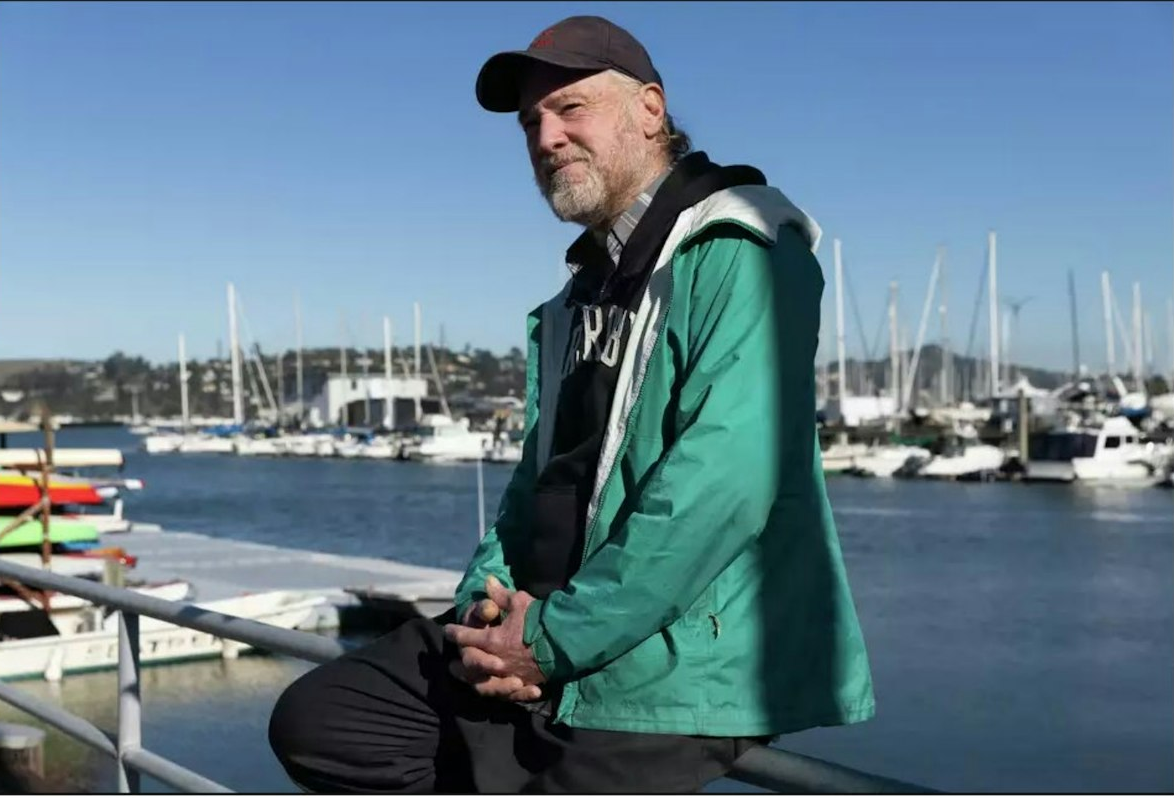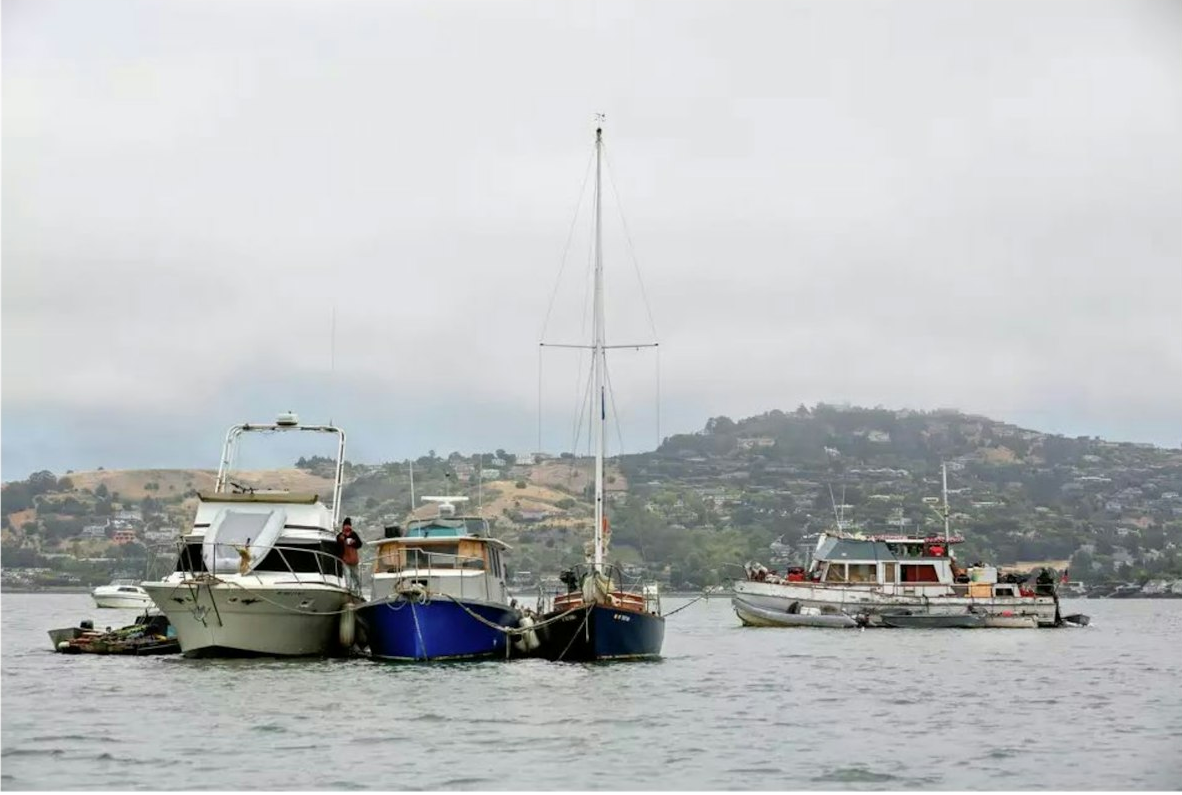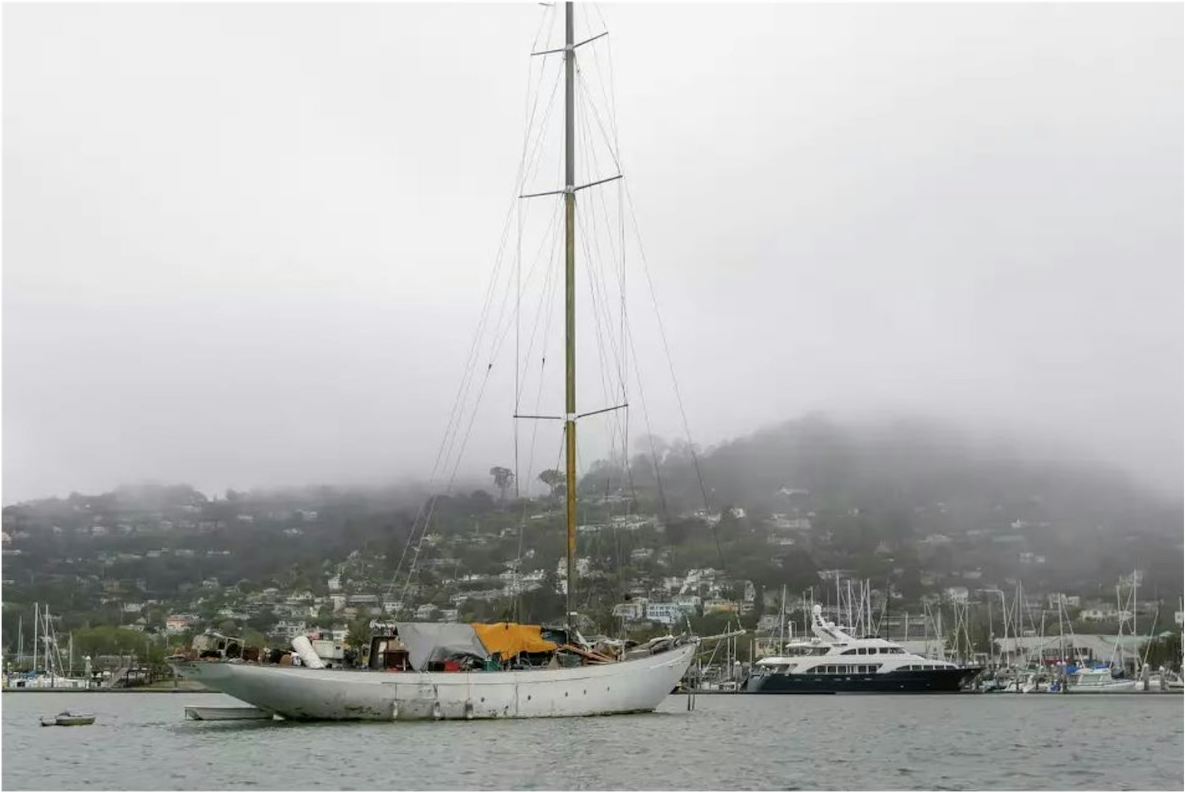Sausalito’s $3 million plan to clear illegal boats from Richardson Bay is working
By J.K. DineenUpdated March 2, 2024 8:21 a.m.

Drew Warner has been a longtime resident of Richardson Bay until he utilized a program to transition from his boat to housing on land.
Benjamin Fanjoy/The Chronicle
In late January, after 23 years among the saltiest of Sausalito’s anchor outs, Drew Warner rowed his dingy to Schoonmaker Beach for the last time. All he carried was a bag of clothes and his tabby cat Charlie.
He had given away his anchor gear and rope, his generator and other supplies. He turned his skiff and a kayak over to the Richardson Bay Regional Agency, along with the 26-foot sailboat that had been his home for the past five years.
There was nothing else he wanted from the life he was leaving behind.
“I said, ‘Tow it, baby, I’m done,’ ” Warner recalled.

A cluster of live-aboard boats is seen in the anchorage in Richardson Bay in Sausalito in 2021. The longtime anchorage community and nearby encampment have been battling with the city of Sausalito and regional agencies over being displaced out of the water and on land.
Amy Osborne/Special to the Chronicle
Warner is one of 10 anchor outs — people who live rent free on vessels — who have taken advantage of a $3 million program aimed at removing them from Richardson Bay, which sits between the Marin County cities of Sausalito and Tiburon. Under the rules, anchor outs are eligible to receive a housing voucher for an apartment on land, as well as a $150 per foot “buy back” for the vessel being hauled out of the water.
With another five anchor-outs in the process of securing housing on land, Sausalito and Richardson Bay authorities are optimistic that the program is accomplishing what multiple efforts in the past have failed to do: clear the waterway of a fleet of, often, dilapidated and unseaworthy vessels that, for decades, have been held up as a romantic symbol of Sausalito’s famous funkiness. The vessels are a thorn in the side of environmentalists who are trying to restore the bay’s eelgrass beds, which are a vital spawning ground for herring and a central component of an ecosystem that supports everything from terns to whales.
“We are not just telling people to leave the water — we are offering them housing,” said Marin County Supervisor Stephanie Moulton-Peters, who represents Sausalito. “It is one of the most compassionate approaches to those living on the water and our need to move them.”
Over the years, officials have been largely unsuccessful in dealing with the anchor outs, who have had support from many residents who regard the lifestyle as part of Sausalito’s maritime traditions. The Richardson Bay Regional Agency, or RBRA, attempted to enforce laws that limit vessels anchored in the bay to 72 hours, unless a 30-day permit is applied for and approved. Those efforts were mostly ignored. The Marin County Sheriff’s Department would conduct raids on the anchor outs, looking for stolen goods or drugs.
“We had a lot of shakedowns,” Warner said. “They thought we had a meth lab out there. What a big joke that was. Not even close. You can’t manufacture that stuff on the water.”
During the pandemic, the campaign to clear the more than 200 boats from the bay was stepped up, but progress was slow. Initially, RBRA set up a program where anchor outs could apply to move their boats into slips in five of Sausalito’s established marinas. Only two anchor outs took advantage of the offer.

Live-aboard boats are seen in anchorage in the middle of Richardson Bay in Sausalito in 2021. A new program that helps boat residents transition to housing on land is reducing the number of anchor outs who live on the water.
Amy Osborne/Special to the Chronicle
“A lot of the boats were not seaworthy and not something the marina operators were willing to accept,” Moulton-Peters said. “We pivoted and moved to an onshore strategy.”
The onshore strategy involves giving the anchor outs a housing voucher that can be used in Marin County. Typically, the vouchers are for about $2,500. In addition to that, Episcopal Community Services has given a $344,680 contract to provide a caseworker for outreach to those qualifying for the program.
In 2016, there were 240 boats anchored in the bay, a number which has dwindled to about 40, according to RBRA Executive Director Brad Gross. A settlement with the San Francisco Bay Conservation and Development Commission requires that all illegally anchored vessels be removed by October of 2026.
“We should be able to get to the rest of the people in about a year,” he said. “We can house about two people a month.”
Anchor outs that were moored in the bay as of a June 2022 survey are eligible for the buy back program and the voucher.
“What we didn’t want was to announce the program and then get a flood of boats from all of the Bay Area thinking they are going to get a housing voucher,” Gross said.
Warner, 62, arrived in Richardson Bay in 2001. By that time he had already spent 11 years living on the water in a marina in San Mateo County, but had been evicted to make way for a housing development. At a friend’s suggestion, he motored his 36-foot Bayliner to Richardson Bay, and ended up anchoring a few hundred yards out from the Bay Model Visitor Center.
The location worked well for him. He would row back and forth to downtown Sausalito, cleating his skiff to the dingy dock at Schoonmaker Beach, and clocking in at jobs ranging from hotel night manager to gas station attendant to administrator at an appliance store and automobile dealership.
“I never missed a beat,” he said.
In Richardson Bay, he found a community of “wild, wild west” outlaws who could be difficult to get along with — many struggled with addiction and alcoholism, as he did — but who also watched out for one another in what was a dangerous environment. In 23 years Warner went through 13 boats and managed to hold down more than dozen jobs, before retiring seven years ago.
While Warner loved the freedom, and price, of anchoring out, it was dangerous. He said nine neighbors died last year from everything from overdoses to heart attacks to drowning. The storms in recent years have become increasingly severe, leading to more sleepless days of round-the-clock watches.
“You can’t see what is going on at night out there. The wind, the waves, the water, it’s a whiteout. And you can’t sleep anyway. You are pinned to the walls. You are clinging to the mast,” he said. “Living on a boat out there is a big responsibility. Boats break loose during a storm and the whole pile could smash into you. Your boat busts loose and blows ashore? Dude, you are responsible for that guy’s dock.”
A former water polo player, Warner is a strong swimmer — a skill he was forced to put to use on more than one occasion. Once, during a storm, he was rowing back to his boat at 1:30 in the morning when his oar lock broke. He got carried away in the current, eventually ending up “over the bow and in the water.”
Warner’s screams for help were heard by a resident of a houseboat at Galilee Harbor who rowed out into the dark waters to find him. Warner had been wearing warm clothes and a long wool coat when he fell in, but had shed the layers in order to swim. He said he was “done, on my last breath” when the rescuer pulled up.
“I told the guy, ‘I’m coming up naked, dog,’ ” Warner recalled. “Man, you have to get rid of your clothes when you hit that water. I don’t care if you are embarrassed or not.”
Warner said some of the hard-core anchor outs regarded the housing voucher program with skepticism, but others have come to embrace it. Two other anchor outs took units at Summit at Sausalito, where Warner moved.
“All these anchor outs — Pump Out Bob, Caribbean Bob — they were all saying ‘Drew, you’re just a sell out, f— that s—, no way.’ Guess what? They all followed my footsteps,” he said.
From the decks of his new apartment on a Marin City hilltop, Warner looks across the Richardson Bay Bridge toward Strawberry. He can see the twinkling lights of Belvedere. And he can watch the churning blues and grays of Richardson Bay, the very spot where he anchored for all those years.
After 23 years on the water, living in a one-bedroom townhome-style apartment with wall-to-wall carpeting has been so strange he didn’t sleep for three days after he moved in last month.
Yet, Warner said he now feels like he’s “living on top of the world.”
“I’ve got two balconies — upper floor, lower floor, stainless steel kitchen, washer and dryer,” he said. “The place looks like something out of Martha Stewart.”
Reach J.K. Dineen: jdineen@sfchronicle.com
March 2, 2024|Updated March 2, 2024 8:21 a.m.
By J.K. Dineen
